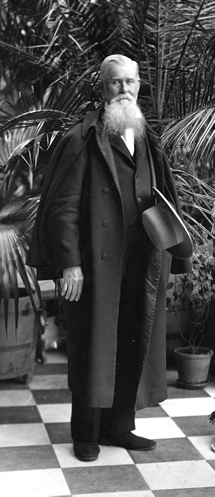Jay Cooke

This was the man of whom Ulysses S. Grant was speaking, on the eve of Lee’s surrender, when he said “Tell him that it is to his labors more than those of any other man that the people of this country owe the continued life of the nation.” Cooke had arranged loans for the government, and sold bonds that financed the Union during the Civil War.
Born in Sandusky, Ohio in 1821, Cooke was the son of a prominent lawyer and member of Congress. He grew up at the site of a lodge once occupied by a chief of the Wyandotte tribe, Chief Ogontz. Cooke recalled that the chief would visit their home for weeks at a time, delighting the children with tales of “Indian” adventures. So impressed was he with the qualities he found in the Chief—bravery, loyalty, integrity—that later he would name another, much larger home “Ogontz.”
When the Civil War started, Cooke had worked his way through the business ranks and was a senior member of the financial firm Jay Cooke & Co. in Philadelphia. He had amassed a huge personal fortune. At the government's request, Cooke financed—through a syndicate of bankers—a $50 million loan. Then he was asked to represent the government, acquiring another $2.5 billion. Later, when Lincoln was shot, he averted a national financial panic by subsidizing the price of government bonds.
Cooke broke ground for Ogontz, his million-dollar mansion in suburban Elkins Park, in 1865. The magnificent stone building with its many porches, turrets, and marble balustrades, was five stories high—each story about twice as tall as normal—and housed numerous drawing rooms, amusement rooms, and libraries. The grounds were also widely admired, with magnificent gardens, broad verandas, and in the fashion of the times, a newly constructed “ruin” (an imitation of an English castle ruin). Prominent people from around the world dined at the mansion, including President Grant and many in his cabinet, Prince Iwakura of Japan and members of the Japanese Embassy, bishops, financiers, and various famous individuals of the time.
In 1873, Cooke’s failure in the financing of the Northern Pacific Railroad nearly ruined him. Few could recover from such a disaster, but Cooke did manage to save the fortune of his associates, and rebuild his own as well. Eventually, the Northern Pacific became the most successful of any of the great Continental railroads.
By 1883 the Ogontz mansion, which was a great expense, had been vacated by Cooke and his two married daughters and their families, all of whom had moved to smaller quarters on the property. Since the mansion was large enough to easily accommodate a hundred girls, he offered to rent it to the principals of The Chestnut Street Seminary for $15,000 a year. After the move, the school adopted the name of Cooke’s estate and became The Ogontz School for Young Ladies. Cooke backed the new venture with his personal influence and sound advice. For example, it was he who suggested that it would be suitable to advertise the school’s new location in a few of the best magazines, starting with Atlantic Monthly.
His own six granddaughters and their many friends became students at the school, and Cooke was viewed as a benevolent grandfather figure to the entire student body. Much beloved, he always had pockets full of little treats for the girls—candy, nuts, fruit. When he died in 1905, the students marked his passing with bereavement at the loss of his “genial spirit and loving interest in the joys of youth.”
Chief Ogontz
Some question arises as to whether Cooke actually knew the historic Chief Ogontz, whose life is legendary. He probably did.
Born in the far Northwest, Ogontz was taken as a baby to be raised by French Catholic priests from Quebec after the others of his village had died from smallpox or fled. He was educated to be a missionary to native tribes, and about the time of the American Revolution, went among the Ottowas to preach Christianity. Having a strong dislike of the British provisional governor, he persuaded two tribes and some French settlers to relocate in Sandusky. The French settled on the peninsula, the Indians on the other side of the bay. There, Ogontz lived at the site of what would later become the property of Eleutheros Cooke, Jay Cooke’s father.
Ogontz decided he could be more useful as a leader than a priest, so he was adopted into one of the tribes and became its chief. This provoked the jealousy of the other tribe’s chief, who tried to sneak up and kill him. But Ogontz was on his guard and slayed his attacker instead. Although it was self-defense, a council was held to decide his fate. In an unusual move, the council decided to spare him, and he adopted the son of the man he had killed, though he knew someday the boy would avenge his father’s death.
Always on the side of peace, Ogontz foresaw the War of 1812 and led his people back to Canada so they would not become involved. After peace was declared, he and his tribe moved again to Maumee River. At a powwow there some time later, Ogontz was killed by his adopted son, as he always knew he would be.
From Historical Collections of Ohio, Henry Howe, 1890